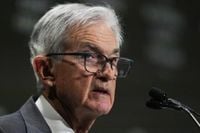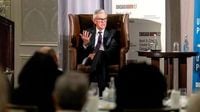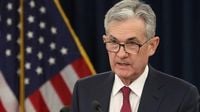On April 16, 2025, stocks plunged sharply on Wall Street, driven by concerns over the economic implications of escalating tariff policies implemented during the Trump administration. Federal Reserve Chair Jerome Powell's stark warnings about stagflation—characterized by stagnant economic growth coupled with rising prices—sent shockwaves through the market, leading to significant losses across major indices.
The Dow Jones Industrial Average fell by 700 points, or 1.7 percent, while the S&P 500 and the Nasdaq Composite experienced declines of 2.3 percent and over 3 percent, respectively. The technology sector was particularly hard hit, with the SPDR NYSE technology exchange-traded fund reporting a 3.1 percent drop on the day.
During a speech at the Economic Club of Chicago, Powell outlined the troubling economic landscape, noting that the economy might be moving away from its goals of stable prices and maximum employment. He stated, "I do think we’ll be moving away from those goals, probably for the balance of this year, and then – or at least not making any progress – and then we’ll resume that progress as we can." This forecast raised alarms among investors and economists alike.
Powell's comments came against a backdrop of anticipated economic slowdown, with the Atlanta Fed projecting a negative GDP growth rate of 2.2 percent for the first quarter of 2025. This is a significant downturn from the previous quarters, which saw growth rates of 3.1 percent and 2.4 percent in the third and fourth quarters of 2024, respectively. Powell remarked, "The data we have in hand so far suggest that growth has slowed in the first quarter of this year," emphasizing the need for caution as the economy navigates these challenges.
One of the central issues raised by Powell was the potential conflict between the Federal Reserve’s dual mandate of maintaining price stability and maximizing employment. He warned that the Fed’s tools can only address one of these goals at a time, stating, "Our tool does only does one of those two things at the same time." This creates a precarious situation where rising prices could coincide with increasing unemployment, complicating the Fed's response to economic conditions.
In his address, Powell highlighted the role of tariffs in this economic scenario, suggesting that they could lead to a temporary rise in inflation. He noted that tariffs imposed during the Trump administration have already exerted upward pressure on prices, stating, "Tariffs are highly likely to generate at least a temporary rise in inflation." This inflationary effect, he cautioned, could persist depending on how quickly the costs associated with tariffs are passed on to consumers.
Powell's assessment aligns with concerns from economists who fear that prolonged tariff policies could generate a general supply shock, similar to what was experienced during the COVID-19 pandemic. He remarked, "If prices rise along with unemployment, the Fed would consider how far the economy is from each goal, and the potentially different time horizons over which those respective gaps would be anticipated to close." This dual challenge places the Fed in a difficult position as it seeks to navigate the complexities of the current economic landscape.
Despite the grim outlook, Powell reassured the audience that the U.S. economy remains fundamentally strong. He stated, "Despite heightened uncertainty and downside risks, the U.S. economy is still in a solid position," although he acknowledged that the current trajectory is concerning. The interplay between consumer spending, which has shown modest growth, and the influx of imports aimed at circumventing tariffs will likely weigh on GDP estimates moving forward.
As the market reacted to Powell's comments, investors were left grappling with the implications of a potential stagflation scenario—a situation where inflation rises even as economic output slows. Such a condition has historically posed significant challenges for policymakers, as raising interest rates to combat inflation could exacerbate unemployment, while lowering rates to stimulate growth could further fuel inflation.
Powell's remarks have reignited discussions about the effectiveness of the Federal Reserve's monetary policy in the face of external pressures such as tariffs. The Fed has adopted a cautious approach, preferring to wait for clearer signals from the White House regarding trade policy before making any significant adjustments to interest rates. Market-based predictions now suggest a slightly increased likelihood of three rate cuts within the year, as investors seek to anticipate the Fed's next moves.
In summary, the economic landscape is fraught with uncertainty as the U.S. grapples with the ramifications of Trump's tariff policies. Powell's warnings reflect a growing concern among economists that the interplay of inflation and stagnation could lead to a challenging economic environment. As the Federal Reserve navigates this complex terrain, the focus will remain on balancing the dual mandates of employment and price stability amid rising economic pressures.








